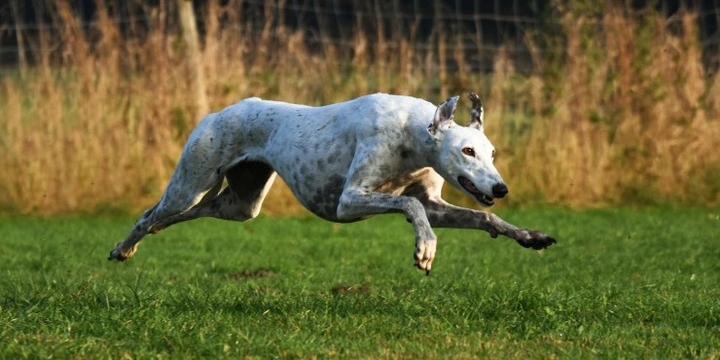
How do greyhounds run so fast?
The Greyhound is the second fastest animal on earth – coming second only to the cheetah, and capable of reaching a flat-out running speed of up to 45mph. If you have ever seen a greyhound take off into an effortless-seeming flat-out gallop, you have probably marvelled at how they can get up to the sort of average speeds that greyhounds commonly display simply playing with other dogs or out on a run, which is of course what made greyhounds popular as racing dogs in the first place.
Additionally, greyhounds can work up to their top speeds very quickly when there is enough flat open space to allow them to build up speed, with a lot of potential energy contained within their lean bodies and sloped hindquarters to power them along.
A lot of the factors that allow the greyhound to run so fast are traits shared with other sighthound breeds, who often have similarly lean, long legged appearances – but the greyhound is the fastest of them all, by some stretch!
If you have ever wondered how come greyhounds can run so fast and what factors help to contribute to their quick, smooth performance at high speeds, wonder no more. In this article we will examine the different factors that contribute to the greyhound’s speed, and their fast running pace. Read on to learn more.
Long legs
While even very small dogs are often very quick and nippy on their feet as well as able to make sharp, sudden turns, to achieve a really top-level running pace, a dog needs long legs – which the greyhound certainly has!
These long, lean legs allow the greyhound to cover the ground at high speed, and their high stomachs and narrow chests allow the dog to achieve full leg extension without compromise.
Lean bodies
In order to be able to run at high speeds, a dog needs to be lean and athletic, but still have plenty of muscle to provide power to their gaits. The Greyhound is of course one of the narrowest or leanest of breeds, without extra padding or unnecessary fat, which both keeps their body weight in proportion to their size low and helps to enable them to run without the resistance of the wind having a significant impact upon their speed.
Streamlining
Greyhounds have very short, fine coats that are single layered and lie very close to the skin. This is why Greyhounds usually need coats and jackets to keep them warm when walking in cold weather, but it also streamlines the dog’s profile and again, provides minimal resistance that might slow the dog down by a couple of degrees when running.
Lung and heart capacity
Greyhounds are tall and very lean, with narrow bodies – but the depth of their chests are comparatively large when taking into account the overall dimensions and build of the dog.
A large chest capacity means comparatively large lungs, which of course helps the Greyhound to oxygenate their blood effectively and support high running speeds, as well as keep running for longer. The Greyhound’s heart is also larger than average too, to support circulation and oxygenation of the muscles even at high speeds.
However, the Greyhound’s top speed can only be maintained in short bursts, and they are certainly built for speed and not endurance!
Head, face and muzzle
The long, straight muzzle of the greyhound and their large nostrils further enable the greyhound to inhale and process a large volume of air for every inhalation that they make, supporting the muscles for high-speed running.
The long, flexible neck of the breed allows them to bring their heads down below the profile of their shoulders when running, further streamlining their profiles and reducing resistance, as well as producing a pointed silhouette facing forwards that helps to support an aerodynamic profile and minimise wind disturbance and again, make the most beneficial use of airflow and wind to build up speed rather than being curbed by it.
Strong hindquarters and spine
The muscles of the Greyhound’s hindquarters are flat, lean and long, providing explosive power for the dog to propel themselves forwards at a run and cover large areas of ground very quickly. The spine of the Greyhound is also very flexible, which is necessary to achieve a high speed.
The superior oxygenation enabled by the muzzle and lung construction of the body helps to support these muscles and avoid the burning ache that accompanies vigorous muscle activity for longer than is average in other breeds.
The double gallop gait
All of these traits combined provide the Greyhound with the right anatomy and build to be a canine record breaker – but their unique running gait itself, which is not displayed by most other dogs, allows the Greyhound to combine all of these factors into an efficient, high-speed gait that eats up the ground.
The Greyhound’s top speed running gait is known as a “double suspension rotary gallop,” which means that for every stride the dog takes at top speed, all four of their legs are suspended from the ground simultaneously twice during the stride’s cycle. This provides an extra burst of speed that makes the Greyhound the fastest dog, and second-fastest animal, in the world.



